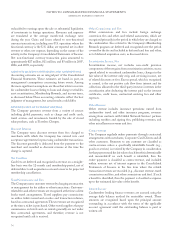American Express 2007 Annual Report Download - page 77
Download and view the complete annual report
Please find page 77 of the 2007 American Express annual report below. You can navigate through the pages in the report by either clicking on the pages listed below, or by using the keyword search tool below to find specific information within the annual report.NOTES TO CONSOLIDATED FINANCIAL STATEMENTS
AMERICAN EXPRESS COMPANY
Other interest income primarily relates to the Company’s
performing fixed-income securities. Interest income is accrued
as earned using the effective interest method, which adjusts
the yield for security premiums and discounts, fees and other
payments, so that the related security recognizes a constant rate
of return on the outstanding balance throughout its term.These
amounts are recognized until these securities are in default or
when it is likely that future interest payments will not be made
as scheduled.
Interest Expense
Interest expense includes interest incurred primarily to fund
cardmember lending, charge card product receivables and
general corporate purposes.
EXPENSES
Stock-based Compensation
Effective July 1, 2005, the Company adopted SFAS No. 123
(revised 2004), “Share-Based Payment” (SFAS No. 123(R)),
using the modified prospective application. The adoption of
SFAS No. 123(R) requires entities to measure and recognize
the cost of employee services received in exchange for an award
of equity instruments based on the grant-date fair value of the
award. The adoption of SFAS No. 123(R) did not materially
impact the Company’s Consolidated Financial Statements
since the Company had been expensing share-based awards
granted after January 1, 2003, under the provisions of SFAS
No. 123, “Accounting for Stock-Based Compensation” (SFAS
No. 123). The Company recognizes the cost of these awards on
a straight-line basis over their vesting periods.
If the Company had followed the fair value recognition
provisions of SFAS 123(R) for all outstanding and unvested
stock options for the period from January 1, 2005, through
June 30, 2005, pro-forma stock–based compensation would
have increased by $9 million, net of tax, and correspondingly
pro-forma basic and diluted earnings per common share would
have decreased by $0.01.
Marketing, Promotion, Rewards and Cardmember Services
These expenses include the costs of rewards programs (including
Membership Rewards, discussed in the other liabilities section
below), protection plans and complimentary services provided
to cardmembers, and advertising costs, which are expensed in
the year in which the advertising first takes place.
Other, Net Expense
Other, net expense includes general operating expenses,
gains (losses) on sale of assets or businesses not classified as
discontinued operations, and litigation and insurance costs or
settlements.
BALANCE SHEET
Cash and Cash Equivalents
The Company has defined cash equivalents to include time
deposits and other highly liquid investments with original
maturities of 90 days or less.
Accounts Receivable
Cardmember receivables
Cardmember receivables represent amounts due from charge
card customers. These receivables are recorded at the time a
cardmember enters into a point-of-sale transaction with a
merchant. Cardmember receivable balances are presented on
the Consolidated Balance Sheets net of reserves for losses,
discussed below, and includes principal and any related accrued
fees.
Reserves for losses — cardmember receivables
Reserves for losses relating to cardmember receivables represent
management’s best estimate of the losses inherent in the
Company’s outstanding portfolio of receivables. Management’s
evaluation process requires certain estimates and judgments.
Reserves for these losses are primarily based upon models that
analyze specific portfolio statistics and reflect management’s
judgment regarding overall reserve adequacy. The analytic
models take into account several factors, including average
write-off rates for various stages of receivable aging (i.e., current,
30 days, 60 days, 90 days) over a 24-month period and average
bankruptcy and recovery rates. Management considers whether
to adjust the analytic models based on other factors, such as
the level of coverage and recent trends of past-due accounts,
as well as leading economic and market indicators, such as the
unemployment rate, consumer confidence index, purchasing
manager’s index, bankruptcy filings, concentration of credit risk
such as based on tenure, industry or geographic regions, and the
legal and regulatory environment.
Cardmember receivable balances are written off when
management deems amounts to be uncollectible and is generally
determined by the number of days past due. Receivables in
bankruptcy or owed by deceased individuals are written off
upon notification, while other accounts are written off when
360 days past due.
Investments
Investments include debt and equity securities and are classified
within both the Available-for-Sale and Trading categories.
Available-for-Sale investment securities are carried at fair
value on the Consolidated Balance Sheets with unrealized
gains (losses) recorded in accumulated other comprehensive
(loss) income, net of income tax provisions (benefits). Realized
gains and losses on these securities are recognized in results
of operations upon disposition of the securities using the
75
























